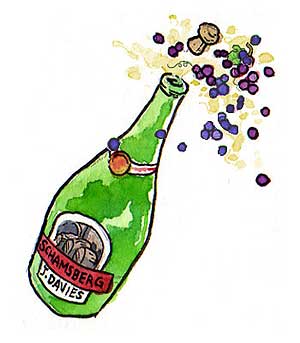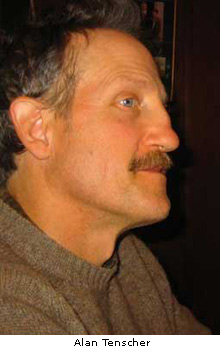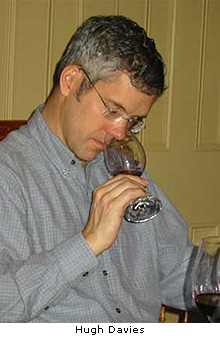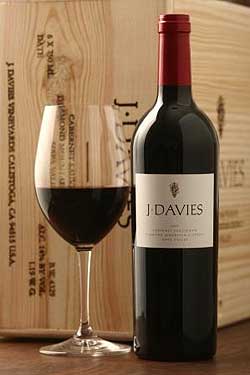

Sparkling wine producer Schramsberg found its land was more suited to growing Cabernet grapes, which now grace its J. Davies wines.
Diamond Mountain District ~ Napa Valley (AVA)
J. Davies: Why Did Sparkling Wine Producer Schramsberg Turn To Cabernet?
A. It’s the terroir, stupid.
by
Alan Goldfarb
January 15, 2007
Alan Goldfarb (AG): What was the genesis of the J. Davies project?
Alan Tenscher (AT): What became clear to us is that the site was just not the right spot for premium white wines. … We began by planting Petite Sirah, Zinfandel, Sangiovese, Cabernet, and Merlot on different rootstocks in two different locations by the grove (above the winery) and in the upper vineyards (which became known as the Tanque Block), in ’94.
It became clear that the best grapes seemed to be Cabernet. Zin lacked real fruit concentration, Petite Sirah was of some interest, but we knew that we wouldn’t be able to compete with Stags’ Leap Winery. At the same time, good things were happening on the mountain with Diamond Creek, von Strasser, and Reverie. We moved in that direction.
AG: Did the suggestion to pull out the Chardonnay and Pinot Noir come from you?
AT: I feel it did. With the increasing corporate consolidation of the wine industry, I wanted to make sure that the Davies would be able to keep making the best wine they can on that property.
Hugh Davies (HD): Alan was driving the production decisions with the input of my parents. The replanting was planned by Alan. He initiated the plan and designed the first plantings and worked to get my parents and everybody else on board.
AG: I’m guessing there was resistance from Jack.
AT: Initially, there was resistance from Jack, but as I was leaving, the three boys (brothers) – Bill, Hugh, and John – were there for a board meeting. I asked, “What do you think we ought to do to go forward?
“You have the best opportunity with red wine. The white (and Pinot) will be a liability. No still-wine producer would want to buy those grapes. … I don’t know of sparkling grapes that come off of red soils; and the climate, which is too hot and not good for acidity, is wrong. The Pinot Noir is coarse and the fruit is dried out. The Chardonnay is slightly astringent.”
Maybe in ’67 (when the first sparkling wine was released by Schramsberg), the grapes were different because (now) the climate has warmed. They took heed.
Jack was a great mentor to me. His resistance, I think, was his desire to have the wine that he was making at the time be from the property. It had to be place, place, place. Bollinger and Krug were the Champagne houses that Jack took as his models. It just turned out not to be the best thing. … Over time he had to warm to the idea. Without his blessing it wouldn’t have happened.
HD: As this process was evolving, it became clear that our best Pinot Noir and Chardonnay was no longer coming from this property. As much as we might not have wanted to do something different … the second group of younger winemakers (here) felt we could do something different. It took a while to convince everybody.
At that stage in his (my dad’s) thinking, this wasn’t necessarily something that he was driving us to do. This was his baby with my mom (Jamie). Here comes another idea that wasn’t necessarily his, so it just took a little while for him to get as excited about it as some of the rest of us were. In the end, I think he was pretty excited.
AG: Tell me about the Malbec on this property. I understand it’s becoming very important for the project.
AT: It produces a very dark, inky wine, not with great structure, but it adds a nice dimension. It’s a consistent, consistent producer.
HD: It’s a pretty exciting variety for us to work with. It continues to grow on us. Malbec is probably the one, from my perspective, when you get it to the ultimate ripe stage, you’ve got a bigger berry. Which means the skin is less, but inside you have a little juice ball – boom! There can be some tremendous pop in those grapes. Months down the road, you can still taste the big burst of flavor.
It’s somewhat thin, so it’s something that can be used as a highlight rather than the core of this Cabernet.
AG: And the Merlot and Petit Verdot?
AT: The Merlot hasn’t made the blend yet and the Petit Verdot does a respectable job.
AG: What have you learned thus far from the project?
HD: We’re on a great track. We’re making some great wine. This is an historic site. We also know (that) it is an area that will develop into a great Cabernet Sauvignon-based site.
I’m always amused when people say the ’61 Cheval Blanc was the best wine made. But I say, no, no, wait, wait. The best is coming.
AG: Do you really think you can make the best Cabernet here?
HD: Absolutely. I don’t know if I tasted the ’61 Cheval Blanc or the ‘90 Y’quem but I’m dubious that a California wine is not on the list. We have a shot to make one of the very best wines. But there is no perfect wine.
AG: I know you. I think you’re always looking to make the perfect wine.
HD: I don’t know about perfect, but I’m always looking to perfect. Its always a mistake to think that you’ve made the perfect wine because where do you go from there? Does that mean that maybe we should stop making music because Beethoven got it right 100 years ago?
AG: I’ve sat in on a few of your in-house sparkling wine tastings with your staff and others, where you pit your sparklers against some of the world’s great Champagnes. And yours does very well.
You know, I recently tasted your J. Davies with 11 other high-end Napa Valley Cabs at {a blind tasting} which your staff and other winemakers and some sommeliers attended. The J. Davies did not fare so well.
It’s awfully brave of you to do that, but, I dare say you leave yourself open for scrutiny. Why do you do it?
HD: It was just one day, one tasting. It’s one panel. It’s not necessarily the result that the competitive sportsman is looking for.
(But) it is one way of forcing ourselves to evaluate the wine. … We have historically done these tastings internally … but over the course of time, we’ve collected the notes and gone back to the drawing board and asked what we can do to add to it or what we want it to be. How is it different? And is that a direction that we want to go in?
Part of it is just developing a language. We’ve been making a sparkling wine for a long time. I think we’re getting into the zone with the Cabs.
AG: What do you think is the future for J. Davies?
AT:<
Alan Tenscher (AT): What became clear to us is that the site was just not the right spot for premium white wines. … We began by planting Petite Sirah, Zinfandel, Sangiovese, Cabernet, and Merlot on different rootstocks in two different locations by the grove (above the winery) and in the upper vineyards (which became known as the Tanque Block), in ’94.

It became clear that the best grapes seemed to be Cabernet. Zin lacked real fruit concentration, Petite Sirah was of some interest, but we knew that we wouldn’t be able to compete with Stags’ Leap Winery. At the same time, good things were happening on the mountain with Diamond Creek, von Strasser, and Reverie. We moved in that direction.
AG: Did the suggestion to pull out the Chardonnay and Pinot Noir come from you?
AT: I feel it did. With the increasing corporate consolidation of the wine industry, I wanted to make sure that the Davies would be able to keep making the best wine they can on that property.
Hugh Davies (HD): Alan was driving the production decisions with the input of my parents. The replanting was planned by Alan. He initiated the plan and designed the first plantings and worked to get my parents and everybody else on board.
AG: I’m guessing there was resistance from Jack.
AT: Initially, there was resistance from Jack, but as I was leaving, the three boys (brothers) – Bill, Hugh, and John – were there for a board meeting. I asked, “What do you think we ought to do to go forward?
“You have the best opportunity with red wine. The white (and Pinot) will be a liability. No still-wine producer would want to buy those grapes. … I don’t know of sparkling grapes that come off of red soils; and the climate, which is too hot and not good for acidity, is wrong. The Pinot Noir is coarse and the fruit is dried out. The Chardonnay is slightly astringent.”
Maybe in ’67 (when the first sparkling wine was released by Schramsberg), the grapes were different because (now) the climate has warmed. They took heed.
Jack was a great mentor to me. His resistance, I think, was his desire to have the wine that he was making at the time be from the property. It had to be place, place, place. Bollinger and Krug were the Champagne houses that Jack took as his models. It just turned out not to be the best thing. … Over time he had to warm to the idea. Without his blessing it wouldn’t have happened.

HD: As this process was evolving, it became clear that our best Pinot Noir and Chardonnay was no longer coming from this property. As much as we might not have wanted to do something different … the second group of younger winemakers (here) felt we could do something different. It took a while to convince everybody.
At that stage in his (my dad’s) thinking, this wasn’t necessarily something that he was driving us to do. This was his baby with my mom (Jamie). Here comes another idea that wasn’t necessarily his, so it just took a little while for him to get as excited about it as some of the rest of us were. In the end, I think he was pretty excited.
AG: Tell me about the Malbec on this property. I understand it’s becoming very important for the project.
AT: It produces a very dark, inky wine, not with great structure, but it adds a nice dimension. It’s a consistent, consistent producer.
HD: It’s a pretty exciting variety for us to work with. It continues to grow on us. Malbec is probably the one, from my perspective, when you get it to the ultimate ripe stage, you’ve got a bigger berry. Which means the skin is less, but inside you have a little juice ball – boom! There can be some tremendous pop in those grapes. Months down the road, you can still taste the big burst of flavor.
It’s somewhat thin, so it’s something that can be used as a highlight rather than the core of this Cabernet.
AG: And the Merlot and Petit Verdot?
AT: The Merlot hasn’t made the blend yet and the Petit Verdot does a respectable job.
AG: What have you learned thus far from the project?
HD: We’re on a great track. We’re making some great wine. This is an historic site. We also know (that) it is an area that will develop into a great Cabernet Sauvignon-based site.
I’m always amused when people say the ’61 Cheval Blanc was the best wine made. But I say, no, no, wait, wait. The best is coming.
AG: Do you really think you can make the best Cabernet here?
HD: Absolutely. I don’t know if I tasted the ’61 Cheval Blanc or the ‘90 Y’quem but I’m dubious that a California wine is not on the list. We have a shot to make one of the very best wines. But there is no perfect wine.
AG: I know you. I think you’re always looking to make the perfect wine.
HD: I don’t know about perfect, but I’m always looking to perfect. Its always a mistake to think that you’ve made the perfect wine because where do you go from there? Does that mean that maybe we should stop making music because Beethoven got it right 100 years ago?
AG: I’ve sat in on a few of your in-house sparkling wine tastings with your staff and others, where you pit your sparklers against some of the world’s great Champagnes. And yours does very well.
You know, I recently tasted your J. Davies with 11 other high-end Napa Valley Cabs at {a blind tasting} which your staff and other winemakers and some sommeliers attended. The J. Davies did not fare so well.

It’s awfully brave of you to do that, but, I dare say you leave yourself open for scrutiny. Why do you do it?
HD: It was just one day, one tasting. It’s one panel. It’s not necessarily the result that the competitive sportsman is looking for.
(But) it is one way of forcing ourselves to evaluate the wine. … We have historically done these tastings internally … but over the course of time, we’ve collected the notes and gone back to the drawing board and asked what we can do to add to it or what we want it to be. How is it different? And is that a direction that we want to go in?
Part of it is just developing a language. We’ve been making a sparkling wine for a long time. I think we’re getting into the zone with the Cabs.
AG: What do you think is the future for J. Davies?
AT:<















